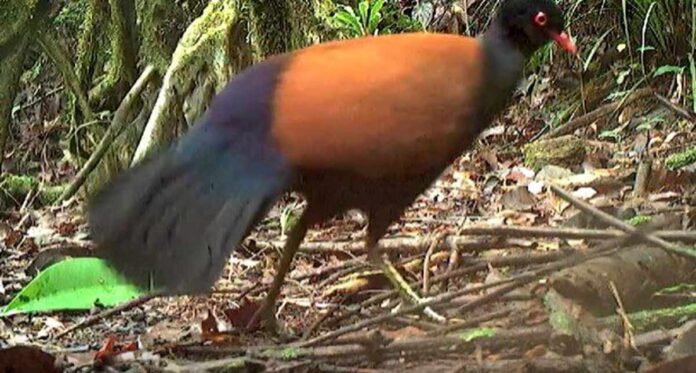The elusive Black-naped Pheasant-Pigeon is a large, ground-dwelling pigeon. That only lives on Fergusson Island, a rugged island in the D’Entrecasteaux Archipelago off eastern Papua New Guinea. This is rediscovered by a team of scientists and conservationists. The Black-naped Pheasant-Pigeon, like other pheasant-pigeons, has a broad and laterally compressed tail that closely resembles a pheasant.
The bird has been observed several times by local hunters over the years. But this is the first time it has been documented by scientists since 1882, when it was first described. Ornithologists know very little about the species, but they believe the Fergusson population is small and declining.
At the end of a month-long search for Ferguson, the research team captured the pheasant with a remote camera trap.
The expedition team, comprised of local Papua New Guineans working with the Papua New Guinea National Museum, the Cornell Lab of Ornithology, and the American Bird Conservancy, arrived on Fergusson in early September 2022. They spent a month travelling around the island. And interviewing locals to determine where to set up camera traps in the hopes of finding the pheasant-pigeon. The steep, mountainous terrain of Fergusson Island made finding the bird extremely difficult.
The expedition was the first camera trapping study ever carried out on Fergusson Island. The team set up 12 camera traps on the slopes of Mt. Kilkerran, Fergusson’s highest peak. And another eight cameras in areas where local hunters had previously reported seeing the pheasant-pigeon.
Augustin Gregory, a local hunter from the village of Duda Ununa west of Mt. Kilkerran, provided a breakthrough lead on where to find the bird. Gregory saw the pheasant-pigeon several times in an area with steep ridges and valleys and described hearing the bird’s distinct calls.
Photos were taken with only two days left in the search
Following Gregory’s advice, the team installed cameras in a dense forest. A camera placed on a ridge near the Kwama River above Duda Ununa at 3,200 feet (1,000 metres) eventually captured the Black-naped Pheasant-Pigeon walking on the forest floor two days before the team was scheduled to leave the island.
Several members of the team have previously attempted to locate the Black-naped Pheasant-Pigeon. Boermsa, Gregg, and Nason conducted a two-week survey in 2019 and found no traces of the bird. Though they did collect reports from local hunters of a bird that could have been the pheasant-pigeon. The survey results aided in determining where the team should look in 2022.
According to the team’s findings, the pheasant-pigeon is extremely rare. The rugged and inaccessible forest where they discovered the species could be the species’ last stronghold on the island.
The American Bird Conservancy (ABC) and the Search for Lost Birds, a collaboration between BirdLife International, ABC, and Re: wild, provided funding for the expedition. The pheasant-pigeon was chosen for an expedition by the Search for Lost Birds after a global review revealed that it was one of a few bird species that had been lost to science for more than a century.

